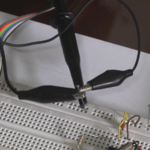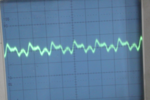juanfhj
Junior Member level 1
I'm making a 16-bit app. I have an AC signal of 100 KHz, 5 mV from a sensor at 1 meter. Noise measured with an oscilloscope is 300 uV. After using INA111 at 1 gain I have 2000 uV noise. My V+ rail (12V) has 4000uV (I guess 500 KHz) noise, uses the LM317. Should I be expecting this?
I never thought the power supply would be critical for a 16-bit app and and instr amp; I've never seen appnotes or books bothering with other than LM317. Should I be expecting that noise from the LM? Should I use other regulator?
I also see some strange high-freq noise from the supply electrolytic capacitors. Is this a sign that they may be damaged? They're 8 years old. Is it a good practice changing them?
I never thought the power supply would be critical for a 16-bit app and and instr amp; I've never seen appnotes or books bothering with other than LM317. Should I be expecting that noise from the LM? Should I use other regulator?
I also see some strange high-freq noise from the supply electrolytic capacitors. Is this a sign that they may be damaged? They're 8 years old. Is it a good practice changing them?



